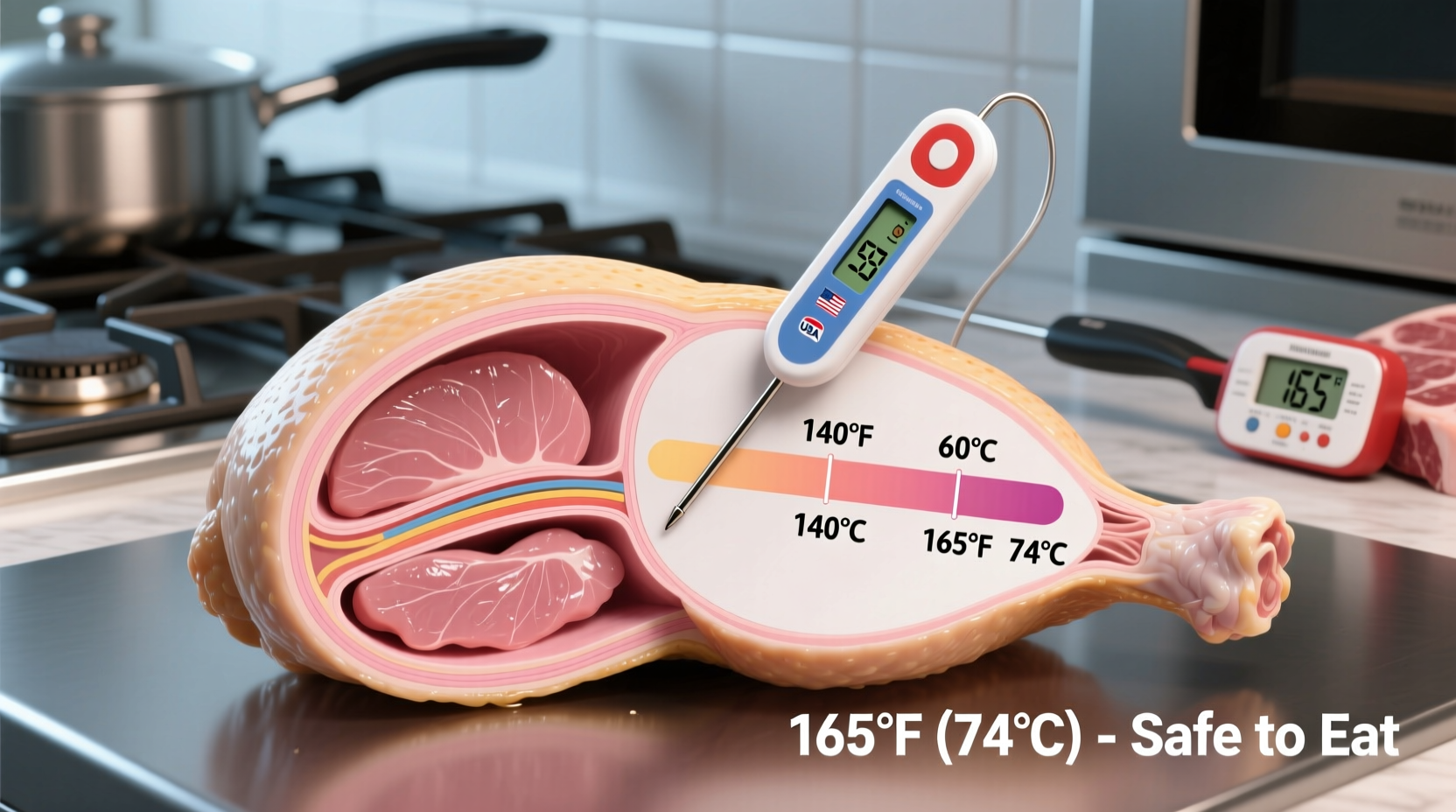Getting chicken cooking temperatures right isn't just about perfect texture—it's a critical food safety requirement that protects you and your family from potentially serious illness. While many home cooks rely on visual cues like clear juices or firm texture, these methods are unreliable indicators of safety. The only accurate way to determine if chicken is properly cooked is by using a food thermometer to verify it has reached 165°F throughout.
Why 165°F Is the Safety Standard
The USDA's 165°F recommendation isn't arbitrary—it's based on extensive food safety research. At this specific temperature, dangerous pathogens like Salmonella are eliminated instantly. Lower temperatures require longer holding times to achieve the same safety level:
| Temperature | Time Required to Kill Pathogens | Practical Application |
|---|---|---|
| 165°F (73.8°C) | Instant | Standard USDA recommendation for all poultry |
| 150°F (65.5°C) | 2.8 minutes | Sous vide cooking only with precise time control |
| 140°F (60°C) | 26.1 minutes | Specialized sous vide techniques only |
This scientific evidence comes directly from the USDA Food Safety and Inspection Service, which continuously updates guidelines based on the latest food microbiology research. For home cooks without precise temperature control equipment, the instant-kill 165°F standard provides the safest approach.
How to Measure Chicken Temperature Correctly
Even when targeting 165°F, improper thermometer use leads to dangerous mistakes. Follow these professional techniques:
- Use the right thermometer: Digital instant-read thermometers provide the most accurate results (within ±0.5°F)
- Target the thickest part: Insert the probe into the deepest section of meat, avoiding bones
- Check multiple spots: Especially for whole chickens or bone-in pieces, verify temperature in several locations
- Wait for stabilization: Hold the thermometer in place until the reading stops changing (about 10-15 seconds)

Common Misconceptions About Chicken Doneness
Many traditional indicators of chicken doneness are dangerously misleading:
- "Clear juices" myth: USDA research shows juices can run clear well before pathogens are destroyed
- "Firm texture" fallacy: Chicken becomes firm around 140°F—still unsafe for consumption
- Pink color confusion: Properly cooked chicken can appear slightly pink due to myoglobin reaction, especially in younger birds
Temperature Guidelines for Different Chicken Cuts
While the 165°F safety standard applies universally, different cuts require specific attention:
- Chicken breasts: Remove from heat at 160°F to account for 5°F carryover cooking during resting
- Thighs and drumsticks: Can be removed at 160°F as dark meat benefits from slightly higher final temperature
- Whole chickens: Check multiple locations including breast, thigh, and wing joints
- Ground chicken: Requires extra care as bacteria can be distributed throughout the meat
Special Cooking Methods and Temperature Considerations
Certain cooking techniques require additional temperature awareness:
- Sous vide: Can safely cook at lower temperatures (145-150°F) but requires precise time control per the FDA Food Code Appendix A
- Smoking: Must still reach 165°F internally despite lower cooking temperatures
- Rotisserie: Verify temperature in multiple spots as heat distribution varies
Remember that oven temperature settings (like 350°F or 400°F) refer to ambient heat, not the internal temperature of the meat. These settings affect cooking time but not the required safe internal temperature.
What to Do If Chicken Is Undercooked
If you discover chicken hasn't reached 165°F:
- Return it to the heat source immediately—do not let it sit at room temperature
- Continue cooking until proper temperature is reached
- Refrain from tasting undercooked chicken
- Thoroughly clean any surfaces that contacted raw or undercooked poultry
When in doubt about chicken safety, follow the food safety maxim: "When you doubt, throw it out." Consuming undercooked poultry carries significant health risks that aren't worth the gamble.











 浙公网安备
33010002000092号
浙公网安备
33010002000092号 浙B2-20120091-4
浙B2-20120091-4